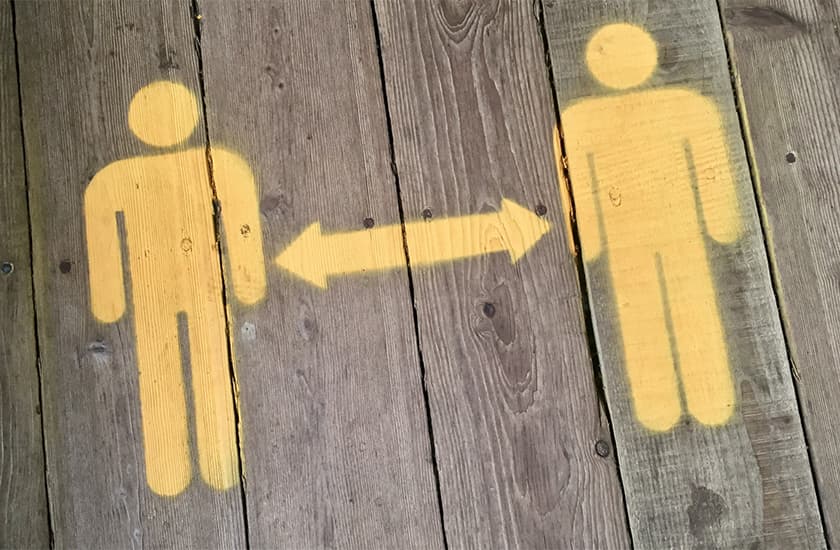Social Distancing Guidance
Tecside Groups number one priority, as it always has been, is the safety, health and wellbeing of our workforce and community.
This information sheet should be read in conjunction with the ‘What you need to know’, ‘Isolation guidance’ and ‘Advice for public gatherings’ information sheets can be found here.
What is social distancing and why is it important?
Social distancing includes ways to stop or slow the spread of infectious diseases. It means less contact between you and other people.
Social distancing is important because COVID-19 is most likely to spread from person-to-person through:
- direct close contact with a person while they are infectious or in the 24 hours before their symptoms appeared
- close contact with a person with a confirmed infection who coughs or sneezes, or
- touching objects or surfaces (such as door handles or tables) contaminated from a cough or sneeze from a person with a confirmed infection, and then touching your mouth or face.
So, the more space between you and others, the harder it is for the virus to spread.
What can I do?
If you are sick, stay away from others – that is the most important thing you can do.
You should also practise good hand and sneeze/cough hygiene:
- wash your hands frequently with soap and water, before and after eating, and after going to the toilet
- cover your cough and sneeze, dispose of tissues, and use alcohol-based hand sanitiser, and
- if unwell, avoid contact with others (stay more than 1.5 metres from people).
As well as these, you can start a range of social distancing and low cost hygiene actions now.
These simple, common sense actions help reduce risk to you and to others. They will help to slow the spread of disease in the community – and you can use them every day – in your home, workplace, school and while out in public.
Social distancing at home
Households
To reduce the spread of germs1:
- As mentioned, practise good hand and sneeze/cough hygiene
- Avoid handshaking and kissing
- Regularly disinfect high touch surfaces, such as tables, kitchen benches and doorknobs
- Increase ventilation in the home by opening windows or adjusting air conditioning
- Visit shops sparingly and buy more goods and services online
- Consider whether outings and travel, both individual and family, are sensible and necessary
Households where people are ill* (in addition to the measures above)
- Care for the sick person in a single room if possible
- Keep the number of carers to a minimum
- Keep the door to the sick person’s room closed and, if possible, a window open
- Both the sick person and the people caring for them should wear a surgical mask when they are in the same room
- Protect other vulnerable family members, such as people over 65 years or people with a chronic illness, including, if practicable, finding alternative accommodation
Social distancing in the workplace
To reduce the spread of germs in the workplace[1]:
- Stay at home if you are sick
- Stop handshaking as a greeting
- Hold meetings via video conferencing or phone call
- Defer large meetings
- Hold essential meetings outside in the open air if possible
- Promote good hand and sneeze/cough hygiene and provide hand sanitisers for all staff and workers
- Take lunch at your desk or outside rather than in the lunch room
- Clean and disinfect high touch surfaces regularly
- Consider opening windows and adjusting air conditioning for more ventilation
- Limit food handling and sharing of food in the workplace
- Reconsider non-essential business travel
- Promote strictest hygiene among food preparation (canteen) staff and their close contacts
- Consider if large gatherings can be rescheduled, staggered or cancelled
Social distancing in schools
To reduce the spread of germs in schools1:
- If your child is sick, do not send them to school (or childcare)
- Sanitise hands when entering school and at regular intervals
- Defer activities that lead to mixing between classes and years
- Avoid queuing and consider cancelling school assemblies
- Promote a regular handwashing schedule
- Clean and disinfect high touch surfaces regularly
- Conduct lessons outdoors where possible
- Consider opening windows and adjusting conditioning for more ventilation
- Promote strictest hygiene among food preparation (canteen) staff and their close contacts
Social distancing in public
To reduce the spread of germs:
- Sanitise your hands wherever possible, including entering and leaving buildings
- Use tap and pay rather than handling money
- Try and travel at quiet times and try to avoid crowds
- Public transport workers and taxi drivers should open vehicle windows where possible, and regularly clean and disinfect high touch surfaces
Things to consider when organising public gatherings
Events where a large number of people are in one place can increase the risk of transmission of viruses. If you are organising a gathering, consider whether you can postpone, reduce size/frequency or cancel the event. If you decide to go ahead, you should assess the risks and reconsider any aspect that may increase risk of transmission.
From Monday 16 March, the Australian Government advises that non-essential gatherings should be limited to less than 500 people; and non-essential meetings of critical workforces such as healthcare workers and emergency service workers should be limited.
For more information about public gatherings, go to the information on public gatherings.
More information
For more information about reducing the spread of COVID-19 in the workplace follow the link.
For the latest advice, information and resources, go to www.health.gov.au
Call the National Coronavirus Help Line on 1800 020 080. It operates 24 hours a day, seven days a week. If you require translating or interpreting services, call 131 450.
The phone number of your state or territory public health agency is available at this link.
If you have concerns about your health, speak to your doctor.
Original article sourced from: Australian Government Department of Health

